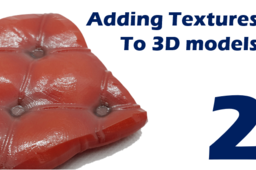TUTORIAL 2: Texture Mapping Using Materialise Magics

In our previous tutorial, we explained what texture mapping is and when you would want to use it. In this tutorial, we will use Materialise® Magics® to demonstrate the actual process for applying textures and adding color to a 3D model.
-
Step 1: Background information
First, a reminder about what texture mapping is and how it works:
Texture mapping is a method for defining high detail, surface texture, or color information on a 3D model. Specifically, it applies an image to a 3D body by unwrapping the 3D object onto a 2D plane and then mapping the mesh coordinates from the unwrapped model onto the 2D image. These coordinates are used to wrap the 2D texture back onto the original 3D surface.
Texture mapping in theory:


-
Step 2: Adding Texture in Materalise Magics
Watch this video to see how to add texture in Magics:
Video summary:
Texturing using Magics
· Ensure that the model that you want to work on is selected in the Parts list in the Modeller Scene window
· Using one of the polygon selection tools (shell), select the model or areas that are to have the texture applied
· Apply a texture via TEXTURE > New Texture
· Navigate to your chosen texture image (wood grain)
· Adjust settings as requires
o Projection (Straight / Cylindrical)
o Positioning
o Size
o Angle
· Click Apply > OK
· Save Model as VRML (Set units as required)
In addition, you can apply color or “Paint” your models in Magics, too:
Video summary:
Basic Surface Painting Using Magics
· Ensure that the model that you want to work on is selected in the Parts list in the Modeller Scene window
· Using one of the polygon selection tools (mark plane), select the model or areas that are to have the texture applied
· Paint the area via TEXTURES > Paint Part
· Use the color picker tool to choose a color
· Click “ok”
· Click “color marked”
· Click “ok”
Brush Painting Using Magics
· For a brush / pen type selection, ensure that the model has enough triangles to enable a smooth selection
· Go to view > shade > triangles if more triangles are required
o Fix > subdivide part
o Enter a small edge length (eg 0.001)
o Click apply
· Use the brush mark tool to select the areas required
o Adjust the size of the brush if required by XXXXX
· Navigate to TEXTURES > Paint Part
· Use the color picker tool to choose a color
· Click “ok”
· Click “color marked”
· Click “ok”
· Once the model has been painted to your satisfaction
· Save Model as VRML (Set units as required)
-
Step 3: Texture Setting OptionsiIn Magics
Magics Texture settings window:

In the Texture setting dialog box, you can set the following:
Rotation Options:


Texture Placement

Texture Projection

You can also tile an image to create a repeating texture pattern.
-
Step 4: Additional Notes
- In certain geometries, wrapping may cause distortion. In the figure below, the leather texture becomes distorted at the end of the model.

- In certain geometries, wrapping may cause distortion. In the figure below, the leather texture becomes distorted at the end of the model.

- For more complex cases, the texturing process can be carried out in an alternate software package, such as Adobe® Photoshop®, Blender®, Autodesk®, Maya®, and 3DS Max®, that allows smarter unwrapping of the 3D model’s surface. However, this process can result in visible seams.
Below is an example of a rewrapped model with visible seams.

- For more complex cases, the texturing process can be carried out in an alternate software package, such as Adobe® Photoshop®, Blender®, Autodesk®, Maya®, and 3DS Max®, that allows smarter unwrapping of the 3D model’s surface. However, this process can result in visible seams.
If this happens, try repositioning the image to place any seams on a less noticeable area of the model
- To improve UV mapping quality and minimize the possibility of errors in the texture, ensure that the mesh density of the model is even and the triangles are formed with similar edge lengths.

-
Step 5: Exporting to VRML/OBJ
When exporting a model with a texture applied, two files are automatically generated
- Mesh file: VRML / OBJ
- Image file: PNG / JPEG

Make sure that both of these files are located in the VRML file you export to GrabCAD Print, so that they both open correctly. Otherwise, you will receive the following error and the model will be imported without either the color or the texture applied.


This completes our tutorial. Feel free to leave us a comment or question below.

